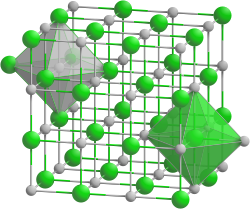Silver bromide
| Crystal structure | |||||||||||||||||||
|---|---|---|---|---|---|---|---|---|---|---|---|---|---|---|---|---|---|---|---|

|
|||||||||||||||||||
| __ Ag + __ Br - | |||||||||||||||||||
| Crystal system |
cubic |
||||||||||||||||||
| Space group |
Fm 3 m (No. 225) |
||||||||||||||||||
| Coordination numbers |
Ag [6], Br [6] |
||||||||||||||||||
| General | |||||||||||||||||||
| Surname | Silver bromide | ||||||||||||||||||
| Ratio formula | AgBr | ||||||||||||||||||
| Brief description |
white to yellowish green solid |
||||||||||||||||||
| External identifiers / databases | |||||||||||||||||||
|
|||||||||||||||||||
| properties | |||||||||||||||||||
| Molar mass | 187.77 g mol −1 | ||||||||||||||||||
| Physical state |
firmly |
||||||||||||||||||
| density |
6.47 g cm −3 |
||||||||||||||||||
| Melting point |
430 ° C |
||||||||||||||||||
| boiling point |
1502 ° C |
||||||||||||||||||
| solubility |
almost insoluble in water, 0.14 mg l −1 (25 ° C) |
||||||||||||||||||
| safety instructions | |||||||||||||||||||
|
|||||||||||||||||||
| Thermodynamic properties | |||||||||||||||||||
| ΔH f 0 |
−100.4 kJ / mol |
||||||||||||||||||
| As far as possible and customary, SI units are used. Unless otherwise noted, the data given apply to standard conditions . | |||||||||||||||||||
Silver bromide is a chemical compound of silver that is one of the bromides . It is a widely used chemical in photochemistry that breaks down when exposed to light.
Occurrence
Silver bromide occurs naturally in the form of the mineral bromogyrite .
Extraction and presentation
Silver bromide precipitates out as a yellowish-whitish precipitate when silver salt, usually silver nitrate, and a soluble bromine salt meet.
The compound can also be obtained by reacting silver with bromine under excess pressure at 500 ° C.
properties
Dry freshly extracted silver bromide looks yellowish. Its melt is orange-red. It is very difficult in water, difficult in concentrated ammonia solution and easily soluble in thiosulphate and cyanide solution. It quickly turns dark in the light as a result of silver deposition through photolytic decomposition . Silver bromide has a cubic crystal structure of the sodium chloride type.
use
→ Main article: Photography
The salt is stored in small crystal fragments in a gelatin layer (or similar substances). When light falls on this, the silver bromide decomposes into its elementary components - silver and bromine ; the bromine evaporates. The exposed crystals stand out from the background because the finely divided silver appears black.
Individual evidence
- ↑ Entry on silver bromide. In: Römpp Online . Georg Thieme Verlag, accessed on November 12, 2014.
- ↑ a b c d e Entry on silver bromide in the GESTIS substance database of the IFA , accessed on February 1, 2016(JavaScript required) .
- ↑ David R. Lide (Ed.): CRC Handbook of Chemistry and Physics . 90th edition. (Internet version: 2010), CRC Press / Taylor and Francis, Boca Raton, FL, Physical Constants of Inorganic Compounds, pp. 4-88.
- ↑ David R. Lide (Ed.): CRC Handbook of Chemistry and Physics . 90th edition. (Internet version: 2010), CRC Press / Taylor and Francis, Boca Raton, FL, Standard Thermodynamic Properties of Chemical Substances, pp. 5-4.
- ↑ C. Doelter, H. Leitmeier: Haloid salts, fluorides, organic compounds (coal, asphalt, petroleum), supplements, general register (final volume) . Springer-Verlag, 2013, ISBN 978-3-642-49884-8 , pp. 72 ( limited preview in Google Book search).
- ^ A b c Egon Wiberg: Inorganic Chemistry . Walter de Gruyter, 1952, ISBN 978-3-11-143954-9 , pp. 442 ( limited preview in Google Book search).
- ↑ a b c Rudolf Keim: Silver Part B 2. Compounds with bromine, iodine and astatine . Springer-Verlag, 2013, ISBN 978-3-662-13330-9 , pp. 94 ( limited preview in Google Book search).
- ↑ RW BERRIMAN, RH HERZ: Twinning and the Tabular Growth of Silver Bromide Crystals. In: Nature. 180, 1957, p. 293, doi : 10.1038 / 180293a0 .


